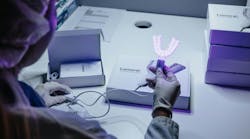New advances in periodontitis treatment: Study on antibacterial treatment making progress in Lithuania
A promising study is underway in Lithuania to investigate the effectiveness of a new antibacterial and light-activated oral hygiene-enhancing method to treat more severe stages of periodontitis. The study “Regular home-use of dual-light photodynamic therapy in the management of chronic stage III–IV periodontitis”—LumoKaunas2023 for short—was launched in August 2023 in Kaunas, Lithuania.1
About the study
LumoKaunas2023 is a clinical study investigating the effects of regular use of the Lumoral device in treating chronic, advanced (stages III–IV) periodontitis. A total of 60 subjects will be recruited, of whom 38 have already joined the study. The principal investigator of the study is Associate Professor Ingrida Pacauskiené, and the research team includes Professor Vita Mačiulskienė, Dr. Renata Šadzevičienė, and Raimonda Guntulytė, dentist.
The Lumoral device, a key component of the study, is a light-activated treatment developed by Finnish scientists that combines a specific mouthwash with antibacterial dual-light therapy. Lumoral is in use in some European and Asian countries but not yet available in the US. Previous studies (including the HOPE-CP trial) have shown this combination to be effective especially in managing earlier stages of periodontitis.2 LumoKaunas2023, aims to investigate whether this treatment is similarly effective for more severe cases of periodontitis that require more intensive treatment.
“With LumoKaunas2023, researchers are now looking to see if light-activated therapy is similarly effective for more severe cases of periodontitis that require more treatment,” says Mikko Kylmänen, clinical research project manager at Koite Health Ltd, who recently visited the Lithuanian research team in Kaunas.
According to Kylmänen, the study process is overseen by a local monitoring company, Insuvia UAB, to ensure high-quality data collection and processing. Close monitoring of the data will help the research team draw reliable conclusions about Lumoral’s effectiveness.
Important information on periodontal treatment
Periodontitis is a common but serious disease that causes inflammation and tissue damage to the gums and supporting tissues around the teeth. More severe cases carry significant risks, including tooth loss and the risk of the infection spreading to other parts of the body.3
The antibacterial effect of the Lumoral device, developed in Finland, offers a new way for treating and preventing gum disease, including more serious periodontal disease, particularly when used as an adjunctive treatment to regular brushing and flossing.2
“The previous Lumoral study, HOPE-CP, showed light-activated therapy to be an effective adjunct treatment for managing earlier stages of periodontitis. LumoKaunas2023 study deepens this knowledge and provides insights into whether the device could also benefit patients with more advanced diseases,” Kylmänen says.
The HOPE-CP trial’s three-month results have shown that eliminating the bacteria contained in dental plaque with antibacterial treatment should be as vital a part of dental hygiene as brushing your teeth and flossing. The research, which is Europe’s largest periodontitis study, is currently being carried out at Metropolia University of Applied Sciences in Helsinki, Finland.2
The study’s results show that 54% (N=59) of participants who used the Lumoral device were healed from inflammation of the gums based on the BOP (bleeding on probing) index—2.5 times more than in the control group that did not use the device. It is important to note that only 22% of participants in the control group had healthy gums after three months. The participants who used Lumoral had a significantly lower plaque buildup, whereas the control group still had the same amount of plaque remaining.2
Meanwhile, the research also shows that two out of three (67%) participants who used the device were able to reduce the number of deep gum pockets by half compared to the initial situation. Four participants were able to eradicate deep gum pockets completely. The results are significantly better than those of the participants in the control group.2
“Our hypothesis was correct: because 95% of dental diseases are caused by bacteria in the plaque, regularly eliminating dental plaque improves dental hygiene and prevents and treats dental and gum disease. The results are exceptional and prove that using Lumoral when treating gum disease makes the treatment a lot more efficient than before,” explains heart and transplant surgeon Tommi Pätilä, one of the developers of Lumoral.
Future perspectives on treating chronic periodontitis
The LumoKaunas2023 study underscores an international effort to investigate the effectiveness of a novel device in managing chronic periodontitis. The Lithuanian study team has made promising strides and is on track to meet its recruitment targets, ensuring the study is completed by early autumn 2025.
“We eagerly anticipate more evidence on how the Lumoral device can enhance periodontitis treatment outcomes, particularly in severe cases,” says Kylmänen, sparking intrigue and eagerness for the future of periodontitis treatment.
Periodontal disease treatment is evolving, and the Lumoral device presents an exciting adjunct to traditional approaches, offering substantial benefits for various patient groups, even those with advanced gum disease. The LumoKaunas2023 study marks an essential step toward more effective treatments supporting oral health and mitigating the impact of periodontal disease. The benefits of Lumoral for patients with advanced gum disease include improved oral hygiene, reduced risk of infection, and more efficient treatment outcomes.
Periodontitis is often asymptomatic for a long time. Unfortunately, dental experts say pain is often the first motivator to get treated.3
“We want to improve at-home dental hygiene permanently. Before, advanced gingivitis was only treated at the dentist, where the waiting lists were long, and the treatment might be expensive. Antibacterial treatment combined with proper treatment from professionals reduces the number of infections in the mouth. Without proper at-home care, treatment done by oral health professionals is not as effective as desired, either, so using Lumoral is also beneficial for them,” Pätilä concludes.2-5
Editor’s note: This article first appeared in Clinical Insights newsletter, a publication of the Endeavor Business Media Dental Group. Read more articles and subscribe.
References
- Regular home use of dual-light photodynamic therapy in the management of chronic periodontitis. TrialScreen. February 8, 2022. Updated February 2, 2024. https://app.trialscreen.org/trials/periodontitis-regular-home-use-dual-light-photodynamic-therapy-management-trial-nct05278416
- Pakarinen S, Saarela RKT, Välimaa H, et al. Home-applied dual-light photodynamic therapy in the treatment of stable chronic periodontitis (HOPE-CP)—three-month interim results. Dent J (Basel). 2022;10(11):206. doi:10.3390/dj10110206
- Overview: Gingivitis and Periodontitis. InformedHealth.org [Internet]. Institute for Quality and Efficiency in Health Care (IQWiG); 2006. [Updated 2023 Aug 23]. https://www.ncbi.nlm.nih.gov/books/NBK279593/
- Lähteenmäki H, Pätilä T, Räisänen IT, Kankuri E, Tervahartiala T, Sorsa T. Repeated home-applied dual-light antibacterial photodynamic therapy can reduce plaque burden, inflammation, and ammp-8 in peri-implant disease-a pilot study. Curr Issues Mol Biol. 2022;44(3):1273-1283. doi:10.3390/cimb44030085
- Trujiilo K, Räisänen IT, Sorsa T, Pätilä T. Repeated daily use of dual-light antibacterial photodynamic therapy in periodontal disease—a case report. Dent J (Basel). 2022;10(9):163. doi:10.3390/dj10090163










